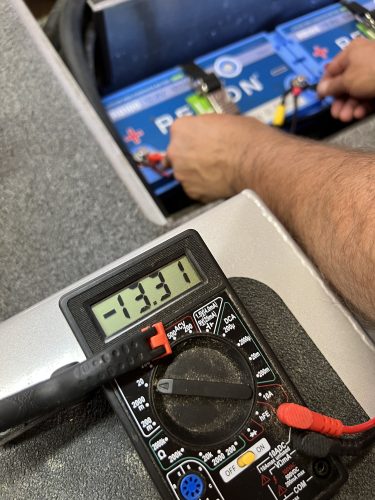Flipping the RELiON Lithium Battery Switch – Part Two: On the Water
By Danny Blandford
In early June I flipped the switch on Relion Lithium batteries and you can read about that here. Since the install I’ve been able to sneak in about 40 hours on the water…a handful of short pre-fishing days, two LONG days, and two tournament days. Cumulatively, the tournament results were “meh”, but that was the angler, not the equipment that lead to those mediocre results. The electrical equipment, on the other hand, performed flawlessly.
My Observations
Long days and tournament days are the ones that test your equipment, so I started right there, with a solid 6 am to 6 pm fishing day, fishing with my original bass fishing mentor, Dad.

It was windy and we spent the first half of the day on the main lake with the bow into the wind, the foot on the trolling motor, and the screens on. I was using live sonar on the bow, as well as mapping and 2D/side-scan sonar running nonstop. One thing that jumped out at me was how little current drop I noticed. My bow screens consistently showed 13.0 V (volts). On occasion, I’d see a dip to 12.9 V, but any time I fired up the outboard to move, I’d drop the trolling motor on the next spot to see it right back at 13.0 V.
The second half of the day Pops and I headed “up the river”, a narrower stump-filled upper reach of the lake. Being that I hadn’t been up there in quite some time, I spent a lot of the time covering water on the trolling motor, dialed to anywhere from 20% to 60% for the remainder of the day…still with all electronics going full bore.
The fishing picked up and the batteries stayed strong. One thing that jumped out at me regarding trolling power is that I didn’t see that speed dial creeping up as the day wore on.
A setting of 20% on my Minn Kota is the sweet spot for moving about and fishing my style; it’s extremely quiet there and it’s a comfortable pace to pick apart targets and make plenty of casts. Prior to switching to the Relions, I’d have to bump that up to as high as 50% for the same speed that 20% would give me at the start of the day. With the new setup, I was at the 20% setting when I started and I was STILL at 20% at the end of the day.
Day 1 on the water was a success. We ended up stumbling on to a few good fish and the Relion Lithium certainly passed the tests. No voltage drop was noticed over 12 hours on either the RB100HP cranking battery or the RB100 trolling motor batteries.
End-of-the-Day Testing
The first thing I wanted to see was the voltage, so I used a multi-meter directly on the batteries, and just like the graphs said, they were still giving 13+ volts after a nearly daylight-to-dark fishing excursion.

I was impressed, but then I was really impressed when I plugged up the Dual Pro Professional Series Charger. My batteries were at 50% discharge, but still giving me 100% to the devices that relied on them.
After a long day on the water, two things were in order, a good charge for the boat and a good meal for the anglers. Ironically, they both took about the same time. After testing, we plugged in the boat, packed the rods and graphs inside for safekeeping, and went to dinner. Dinner did take a while, but when we returned a few hours later, I was shocked to see the charger showing 90% already! I went ahead and respooled a few reels, tied on a few baits for day two, and then went back out to check before bed. I had three green lights in less than 4 hours, after 12 hours on the water…now that’s a good set of batteries AND a good charger!
The Weight Loss Journey
I can’t wrap the article without discussing what happens when you drop 80 pounds out of the back of an aluminum boat; I found the results surprising. Since its first day on the water with the Relions included an extra passenger and gear, I wasn’t sure what to expect. I was pleasantly surprised to see the boat didn’t drop in speed or lift with Dad and his gear joining me, as a matter of fact, I got to top-end speed quicker and noticed the boat was just more “peppy”. What did surprise me was that top-end speed was basically the same as it had always been, although it used to have to just be one person to get those numbers, now I’m getting it with two. The weight savings of lithium allowed me to offset the drag created by passengers and gear with ease. I didn’t gain speed, but I could carry more at the same speeds, whereas before, more gear meant less speed.
The Light Load
Subsequent trips found me out by myself on a few occasions where I was able to check the metrics with a light load and that is where I was surprised. The boat jumped onto plane in a much shorter distance, I could get to max RPMs much quicker, and overall it felt more responsive to the throttle, but I didn’t pick up any top-end speed. My thought is removing the weight from the back has changed the balance of the boat while carrying a light load. I noticed the spray line had moved farther forward towards the bow, regardless of how much trim I used. In simplest terms, the on-pad balance of the boat was designed around a certain amount of weight in the back, in the absence of said weight; the boat rode flatter on the water. A flat running boat has more running surface experiencing friction (drag) from the water, and drag reduces speed. I “may” be able to play with props and find the best of both, but I’m certainly better off than I was.
In summary, the weight savings of lithium provided me with a better hole shot and better throttle response, and it allows the rig to carry a load better at higher speeds. It did not turn my aluminum boat into a rocket, unfortunately…but it does have some new pep in its step. I also noticed my old scum line was about an inch higher than my new scum line, so I’ve reduced my overall draft in the water.
From a power perspective, the Relion Lithium Batteries are ridiculous. You can drink from the well all day and not see a power drop. They charge quickly enough your big motor can help maintain your 12V system while running, and a great charger can bring them back to 100% in hours, not overnight.
At this point, my only concern is that I “could” theoretically run them down and I wouldn’t know I was about out of power until I was actually out of power. Since the Relions give full voltage up until the end, you don’t get those tell-tale clues that you’re running out of juice that lead-acid batteries provide.
I now clearly see the need to better monitor how much juice I’ve used, and most importantly how much juice I have left. The Dual Pro Lithium Battery Gauge and its ap will address this issue. I just need to find a good hole saw for aluminum and the courage to put one more hole in the river rig. That’s going down soon and I’ll be back to share the experience.






















